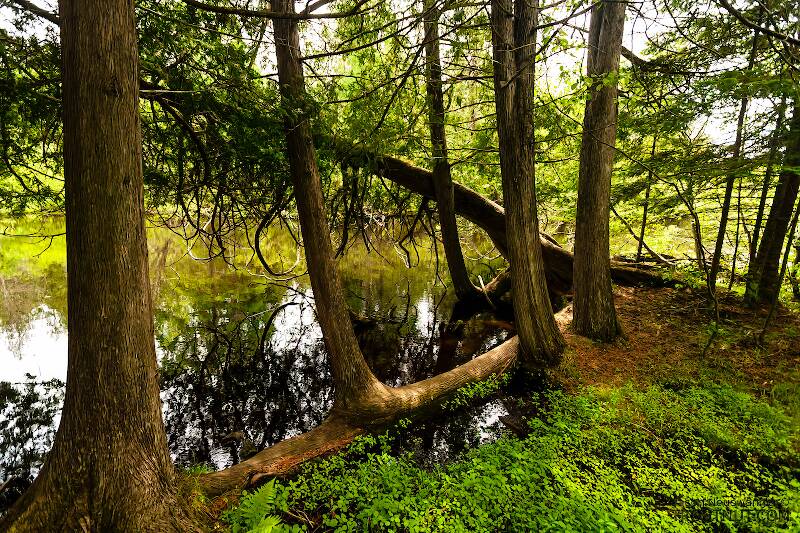
Blue-winged Olives
Baetis
Tiny Baetis mayflies are perhaps the most commonly encountered and imitated by anglers on all American trout streams due to their great abundance, widespread distribution, and trout-friendly emergence habits.

I'm calling this one Pycnopsyche, but it's a bit perplexing. It seems to key definitively to at least Couplet 8 of the Key to Genera of Limnephilidae Larvae. That narrows it down to three genera, and the case seems wrong for the other two. The case looks right for Pycnopsyche, and it fits one of the key characteristics: "Abdominal sternum II without chloride epithelium and abdominal segment IX with only single seta on each side of dorsal sclerite." However, the characteristic "metanotal sa1 sclerites not fused, although often contiguous" does not seem to fit well. Those sclerites sure look fused to me, although I can make out a thin groove in the touching halves in the anterior half under the microscope. Perhaps this is a regional variation.
The only species of Pycnopsyche documented in Washington state is Pycnopsyche guttifera, and the colors and markings around the head of this specimen seem to match very well a specimen of that species from Massachusetts on Bugguide. So I am placing it in that species for now.
Whatever species this is, I photographed another specimen of seemingly the same species from the same spot a couple months later.

Mayfly Species Procloeon simplex (Tiny Sulphur Duns)
Where & when
In 8 records from GBIF, adults of this species have been collected during June (50%), August (38%), and July (13%).
Species Range
Physical description
Most physical descriptions on Troutnut are direct or slightly edited quotes from the original scientific sources describing or updating the species, although there may be errors in copying them to this website. Such descriptions aren't always definitive, because species often turn out to be more variable than the original describers observed. In some cases, only a single specimen was described! However, they are useful starting points.
Male Spinner
Wing length: 5 mm
Abdominal tergites 2-6 of male imago pale whitish hyaline; traces of a black spiracular hair-line.
Turbinate eyes light green in living insect, pale orange-yellow in dried specimen, base deep brown. Head and thoracic notum dark blackish brown; posterior margin of pronotum creamy with a ruddy brown dot; antero-lateral margins of mesonotum paler brown, its posterior margin, the scutellum, and a small patch anterior to it, creamy. Anterior margin of metanotum creamy; pleura largely creamy, with tinges of ruddy brown. Prosternum whitish; mesosterna and metasterna largely brown, the central and lateral areas with creamy shading. Legs wholly pale whitish. Wings hyaline, venation pale; 6 to 7 cross veins in the stigmatic area, no granulations between them. Intercalaries of the 1st and 2nd interspaces wanting. First cross vein between radius and radial sector in a line with the following one.
Abdominal segments 2-6 pale hyaline whitish, with traces of a black hair-line along the spiracular area. Tergites 7-10 opaque, bright chestnut brown, with creamy lateral shading; posterior portion of 10 also creamy. Sternites wholly pale creamy. Tails and forceps white.
The paler eyes, pale thoracic markings and lack of red dots on the abdominal tergites distinguish this species from C. rubropictum (now a synonym of Procloeon rubropictum). The wholly pale legs separate it from C. vicinum (now a synonym of Procloeon vicinum), in which the bases of the fore legs are fulvous.
Start a Discussion of Procloeon simplex
References
- Caucci, Al and Nastasi, Bob. 2004. Hatches II. The Lyons Press.
- Knopp, Malcolm and Robert Cormier. 1997. Mayflies: An Angler's Study of Trout Water Ephemeroptera . The Lyons Press.
- Needham, James G., Jay R. Traver, and Yin-Chi Hsu. 1935. The Biology of Mayflies. Comstock Publishing Company, Inc.
Mayfly Species Procloeon simplex (Tiny Sulphur Duns)
Species Range
Common Name
Resources
- NatureServe
- Integrated Taxonomic Information System
- Global Biodiversity Information Facility
- Described by McDunnough (1925)

